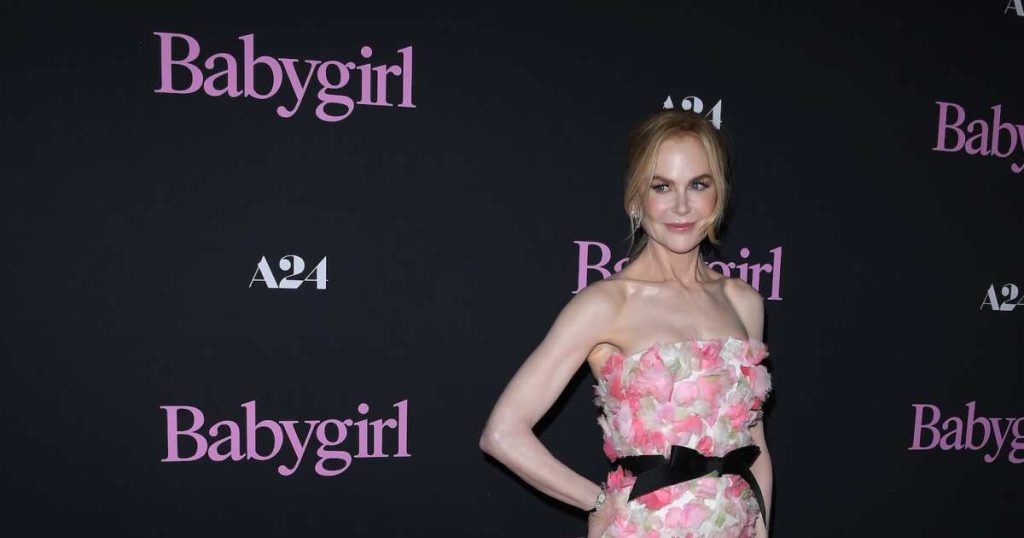Nicole Kidman, renowned actress and producer, adds another feather to her cap, demonstrating her influence extends beyond the screen. In the erotic thriller “Babygirl,” Kidman plays a high-powered CEO entangled in a passionate affair with a much younger intern, a role that demanded not only acting prowess but also behind-the-scenes maneuvering. Director Halina Reijn revealed Kidman’s pivotal role in securing the rights to INXS’s iconic track “Never Tear Us Apart” for a crucial montage scene. Initially, the studio, A24, flatly refused, leaving Reijn sleepless and distraught. However, Kidman, leveraging her industry connections and personal relationship with the director, intervened and successfully obtained the rights, a testament to her dedication and influence. This anecdote underscores Kidman’s multifaceted involvement in the film, going beyond her performance to shape its artistic elements.
“Babygirl” explores the complexities of desire and power dynamics, centering on the relationship between Kidman’s character, a woman at the peak of her career, and a younger man played by Harris Dickinson. The significant age gap between the two characters, 29 years, became a point of discussion and even controversy. Reijn, however, defended this aspect of the film, arguing that such age disparities, when the woman is older, are still viewed with an unwarranted sense of oddity, a reflection of ingrained societal biases. She emphasizes the need to normalize relationships where women are older than their male partners, challenging the double standards perpetuated by the “male gaze” and patriarchal norms that often confine women’s roles and relationships within limited narratives. Reijn’s perspective highlights the film’s attempt to break free from these constraints and present a more nuanced and liberated portrayal of female desire.
Kidman herself echoed this sentiment, expressing her enthusiasm for portraying a character who embraces her sensuality at a stage in life where women are often relegated to less visible or desirable roles. She found the character’s journey relatable, a woman seemingly possessing everything – power, success, and material wealth – yet grappling with questions of identity, desire, and fulfillment. This resonates with a broader cultural conversation about the representation of older women, particularly in Hollywood, where they are often marginalized or stereotyped. Kidman’s willingness to embody such a character speaks to her commitment to exploring complex female experiences and challenging conventional portrayals of women on screen.
The film’s reception has been mixed, ranging from enthusiastic appreciation to outright discomfort. Kidman recounted being taken aback by one particularly strong reaction, where a viewer described “Babygirl” as the “most disturbing film they’ve ever seen.” While acknowledging the intensity of the film’s themes and potentially unsettling nature of the central relationship, Kidman maintained her belief in the film’s liberating potential. This divergence in audience responses underscores the film’s provocative nature and its exploration of themes that challenge societal norms and expectations.
The convergence of Kidman’s acting prowess, her behind-the-scenes influence, and the film’s thematic complexities creates a compelling narrative that extends beyond the screen. Her intervention in securing the rights to “Never Tear Us Apart” speaks volumes about her dedication to the project and her understanding of the song’s significance in enhancing the emotional impact of the film. This anecdote reveals a nuanced layer to Kidman’s involvement, positioning her not merely as an actress delivering a performance but as an active participant in shaping the film’s artistic vision.
In essence, “Babygirl” represents more than just an erotic thriller; it’s a conversation starter, a challenge to societal norms, and a testament to Kidman’s evolving role as an artist. The film’s exploration of age gaps in relationships, the portrayal of female desire, and the deconstruction of the male gaze all contribute to its provocative nature. Kidman’s commitment to the project, evident in both her performance and her behind-the-scenes efforts, further amplifies the film’s message. By embracing a role that defies conventional portrayals of older women, Kidman reinforces her position as a force to be reckoned with in Hollywood, an actress willing to push boundaries and explore complex and challenging narratives. The film’s mixed reception, ranging from disturbance to liberation, further underscores its impact, sparking dialogue and prompting viewers to confront their own preconceptions about age, desire, and female agency.










